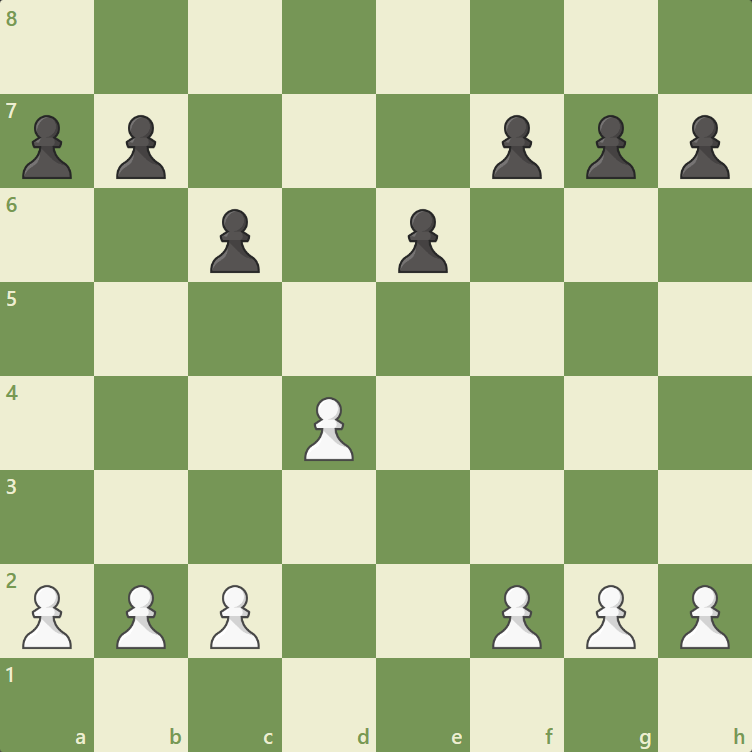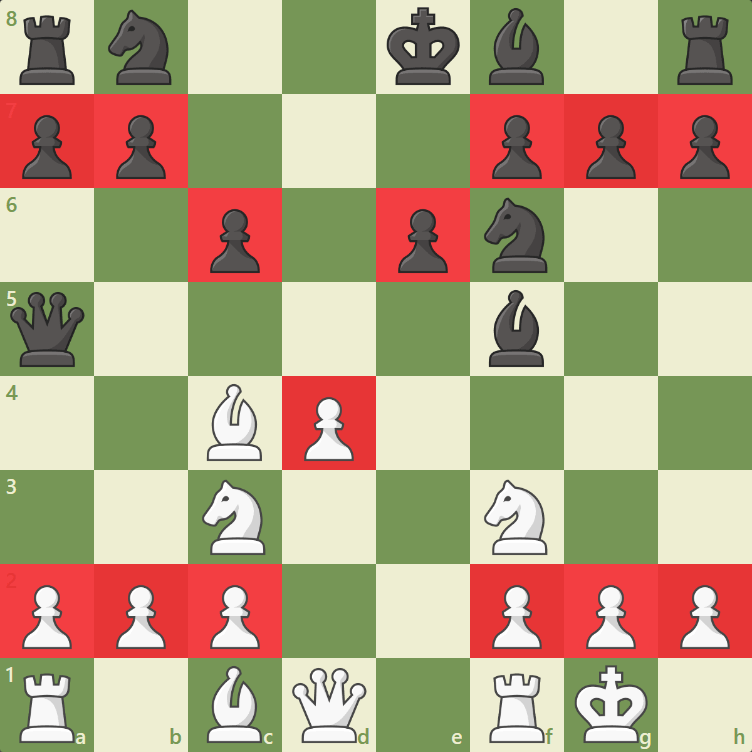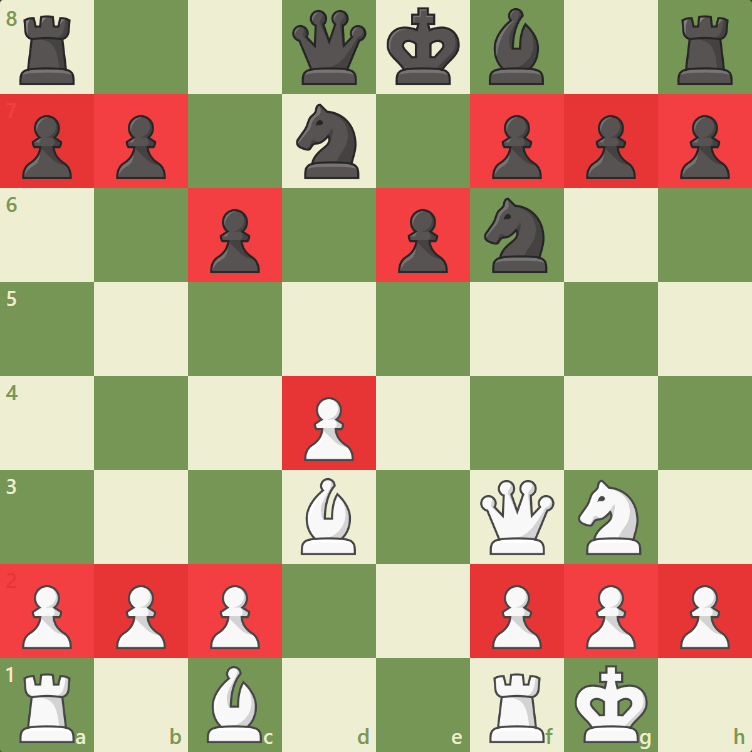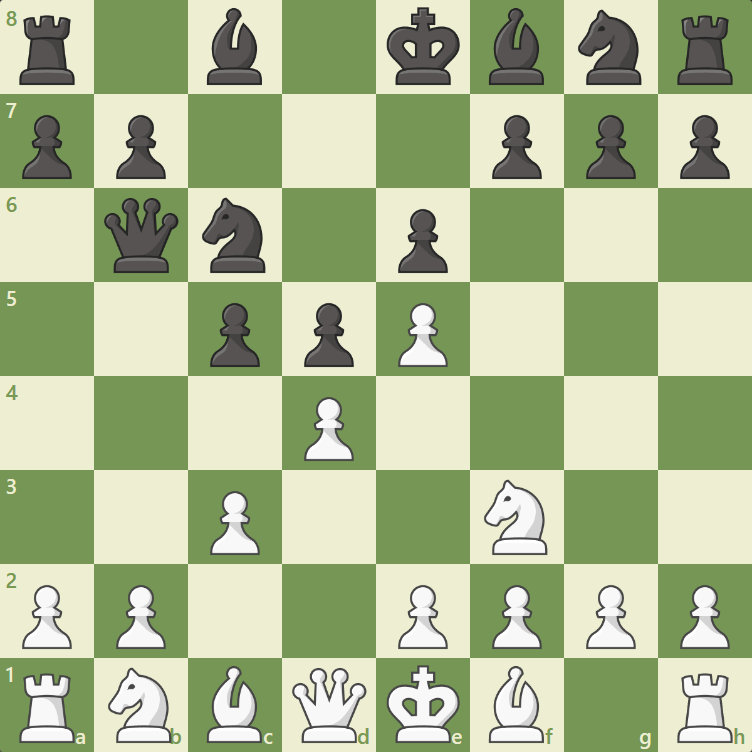
Pawn Structure
"Pawn structure" is a term that is unfamiliar to many beginners, but one that is known to intermediate players (and well-known to advanced players). But what does it mean? Let's find out!
Here is what you need to know about pawn structures:
- What Are Pawn Structures?
- Why Are Pawn Structures Important?
- What Are Pawn Structure Weaknesses?
- Test
- Conclusion
What Are Pawn Structures?
Pawn structure literally refers to the pawn placement or pawn configuration in a position, disregarding all other pieces. Many different types of pawn structures can result from different openings. Some pawn structures can be identical or strikingly similar even though they come from completely different openings! Let's consider the following example:

We can arrive at the pawn structure above from a few different openings. Let's take a look at the position that occurs in the mainline Scandinavian Defense. After the moves 1.e4 d5 2. exd5 Qxd5 3. Nc3 Qa5 4. d4 c6 5. Nf3 Nf6 6. Bc4 Bf5 7. 0-0 e6, the following position occurs:

We can see that the pawn structure from this Scandinavian position is identical to our first pawn structure example. This same pawn structure can be created from the Caro-Kann Defense after the moves 1.e4 c6 2. d4 d5 3. Nc3 dxe4 4. Nxe4 Bf5 5. Ng3 Bg6 6. Nf3 Nd7 6. Bc4 e6:

Pretty neat, huh? Identical pawn structures! What if I tell you that this same structure can also be found in the French Defense? Check it out!

Incredible! After the moves 1. e4 e6 2. d4 d5 3. Nc3 dxe4 4. Nxe4 Bd7 5. Nf3 Bc6 6. Ng3 Nd7 7. Bd3 Ngf6 8. 0-0 Bxf3 9. Qxf3 c6, we have arrived at the same pawn structure. Three completely different openings can have the same pawn structure! As mentioned, there are many types of pawn structures... but why are they important?
Why Are Pawn Structures Important?
Pawn structures are important because they tell us a lot of information about the position. They tell us if a position is open or closed, and can tell us about the nature of the position and sometimes even the strategic goals. For example, the following pawn structure tells us that the position is closed.

This position is considered closed because all of the central pawns are blocked and none of them have been exchanged. Advanced players know that knights are generally more powerful than bishops in closed positions (because bishops have fewer squares to attack if the center is occupied by pawns). Let's look at another example.
In the following position, the pawn structure indicates that the position is open.

This position is considered open because the center pawns have been exchanged and the center squares can be used by pieces. It should be noted that bishops are generally more powerful in open positions, as they are not obstructed by central pawns.
Pawn structures can also help us determine concrete plans or strategic goals. In the following position, Black has castled kingside, but the pawn structure in front of the black king has been weakened.

Since the pawns in front of the black king are weak, this suggests that White should attack the black king! A concrete plan in the above position is Qh5 with the strategic goal of delivering checkmate!
If a pawn structure weakness exists for either side, then it should be noted, as this can guide our current or future plans. Some of you may be asking, "Well, what are pawn structure weaknesses?" Let's find out!
What Are Pawn Structure Weaknesses?
Pawn structure weaknesses (also known as structural weaknesses) can occur in many ways. Doubled pawns, backward pawns, isolated pawns, and holes are the most notable deficiencies in pawn structures. If your opponent has one of these structural weaknesses, you should try to use it against them. If you have a structural weakness, you should be mindful of it.
Let's take a closer look. In the following position, White has doubled c-pawns and an isolated a3-pawn.

The c4-pawn is weak, as it cannot be protected by another pawn. A strategic goal for Black would be to attack and win this c4-pawn (maybe by playing moves like b6/Ba6/Nc6/Na5/Qc7). If we take a closer look at this same pawn structure, we can see that White has three pawn islands, while Black has two pawn islands.

A pawn island is a group of connected pawns. In the diagram above, Black has a pawn island on the queenside (the pawns on a7 and b7) and one on the kingside/center (the pawns on d7, e6, f7, g7, and h7). White has the isolated pawn on a3 (one pawn island); a second pawn island with the pawns on c3, c4 and d4; and a third pawn island with the pawns on f2, g2, and h2. It is better to have fewer pawn islands than more, and it is safe to say that Black has a healthier pawn structure than White in the above position.
In the following diagram, Black has a backward pawn on d6 and a hole on the d5-square.

The d6-pawn is backward because there are no pawns that can support it and because the only adjacent pawn (the e5-pawn) has moved ahead of it. The d5-square is considered a hole where White can potentially put a piece. If White can place a piece on the d5-hole, then Black will be unable to chase it away with a pawn. A strategic goal for White is to attack and win the backward pawn, or to establish a piece on the d5-square.
In the next diagram, we see an example of an isolated pawn.

Black's d5-pawn is isolated, and Black has three pawn islands to White's two pawn islands. A strategic goal for White should be to attack the isolated pawn since it will have no backup from another black pawn. These are just some examples of pawn structure weaknesses or structural weaknesses. There are many other types, so be sure to keep an eye out for them in your opponent's pawn structure and in your own!
Test
Now that you are aware of what healthy pawn structures and weak pawn structures are, let's test some of your new knowledge! Is the following position open or closed?

You got it! The above diagram is a closed position, as all of the central pawns are blocked and none has been exchanged! Let's try another one. Which side has the healthier pawn structure?

Yes! White has a healthier pawn structure because they have two pawn islands (while Black has three) and because Black has doubled pawns on the c-file and an isolated a6-pawn.
Conclusion
You now know what pawn structure means, why pawn structures are important, what structural weaknesses are, and what the difference is between open and closed positions. You can also spot structural weaknesses! Enjoy your new knowledge of pawn structures in your own games!







